Geometrical and Kinematic Analysis and Experimental Modeling Duplexes of Khunik
Rezvane Hamidi1 * , Mahmoud Reza Heyhat1 , Mohammad Mahdi Khatib1 and Masoud Heydari Aghagol1
1
University of Birjand,
Iran
DOI: http://dx.doi.org/10.12944/CWE.10.Special-Issue1.92
The duplexes of Khunik are located at a distance of 18 kilometers in south of Qayen City with a trend of northeast to southwest. Khunik fault is a right-lateral strike-slip fault with a thrust component. Based on the geometry of the duplexas, region was built from two structures of horse tail. In duplexes of this area, are faults have strike-slip mechanism with thrust component. Based on determining of the paleo stress phase, and analysis of existing fractures and shortening trends caused by compression on duplexes of the region, was determined compression, mechanism and it was with maximum axis of N115 stress. The shortening rate was determined as 27.3percent and a total equivalent to 187 meters along the fault by using experimental modeling method in laboratory, which is corresponded with the calculation of the region parameters. According to field surveys and empirical modeling, region duplex has imbricate duplex model.
Copy the following to cite this article:
Hamidi R, Heyhat M. R, Khatib M. M, Aghagol M. H. Geometrical and Kinematic Analysis and Experimental Modeling Duplexes of Khunik. Special Issue of Curr World Environ 2015;10(Special Issue May 2015). DOI:http://dx.doi.org/10.12944/CWE.10.Special-Issue1.92
Copy the following to cite this URL:
Hamidi R, Heyhat M. R, Khatib M. M, Aghagol M. H. Geometrical and Kinematic Analysis and Experimental Modeling Duplexes of Khunik. Special Issue of Curr World Environ 2015;10(Special Issue May 2015). Available from: http://www.cwejournal.org/?p=9855
Download article (pdf)
Citation Manager
Publish History
Select type of program for download
| Endnote EndNote format (Mac & Win) | |
| Reference Manager Ris format (Win only) | |
| Procite Ris format (Win only) | |
| Medlars Format | |
| RefWorks Format RefWorks format (Mac & Win) | |
| BibTex Format BibTex format (Mac & Win) |
Article Publishing History
| Received: | 2014-11-19 |
|---|---|
| Accepted: | 2014-12-30 |
Introduction
In thepresent time, study area is under the influence of a right-lateral transpression regime. Based on the dominant structural trend and the general trend of lithology units, that the mechanism of faults in it show the performance of the shear system and trends of stress of the region consist of two parts:North West to Southeast and North-South (Gholami, 1997). The purpose of this study is to understand the mechanism of formation of duplex and calculating the amount of shortening on fault that caused it.
According to the studies that conducted in East Iran so far, indicate that strike slip faults and its branches, are responsible for most range of the deformation, and perturbations of the stress. Seen in the parts that there are changes and in density of fracture. (Heyhat, 1998)
As ever, a study has not been conducted on existing structures therefore, the results of this study can help to understanding the structural evolution of the region and the development of the sistan suture zone. Among the studies that have been done on this topic in Iran and in other parts of the world, can be summarized as follows:
Conducted a series of experiments on the geometry and the motion of detachment fold belt driven a bow deco leman by poor adhesion (Costa and Vaudeville, 2002), Mechanical analysis and observation duplex organization in the sand box experiments with sight to increasingly complex at West Mediterranean (Nina et al., 2002), the influence of the detachment slope on the geometry and motion the models of duplex (Koji et al., 2003), the model of the motion evolution for growth of ranjit duplexes (Bhattacharyya and Mitra, 2009), structural Analysis chashm strike-slip duplex in East of firouzkouh region (1385), the mechanism of formation of two ridges of haji mountain in north west of brijand. (Rashidi, khatib, heyhat 2011), structural analysis Sliding- compressional duplex of morrow mountain (North West Tabriz) (hasseil abadi, pour kermani, Aaj Ali beigi, 2013).
Geology of the Study Region
Study region is Located in 18 km of south of Qayen (south of khorasan) and in khunik village.
Geology Location withing the study region 59o 15’ east longitudes and 33o 30’-33o 40’ north latitude and is located in distance between sistan and lute region from view of geology. (Aghanabati, 2004).the Province of sistan consists of a chain of strike-slip faults and therefore this region is affected by the processes of the right slip systems (Walker & Jackson 2004). Khunik unit’ s consist of conglomerate, shale, sand stone and basalt (Figure 1).the Lithological of the units that are forming the duplexes, orbito- lina lower cretaceous limestone mass that pushed to the upper cretaceous lime stone.
The direction of Putting the two duplex’s on together from the north west to the southeast and with the along n120 to n160 has various trends, analysis of duplexes geometric and identify the mechanism of parallel faults with it, and giving it, s model is the purpose of this study .
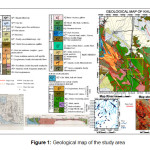 |
Figure 1: Geological map of the study area Click here to View figure |
Methods
To understand the mechanism of duplex and geometrical- kinematic analysis of structural elements in the region, Data for the analysis of structural elements were studied in the field views and satellite images. In addition to the existing geological maps with a scale 1: 100,000 of the fault system in the study area and then in Fault kin Software were analyzed and also to modeling duplex; the tests of sand box were applied In this experiment, three different colors of chalk with the same thickness and viscosity, a fixed ramp at the fixed periphery of the device is applied. Force parallel to the layering, layering the lever enters the controlling factors of structures were studied during testing.
Discussion
Analysis of Structural Elements
In Analysis of elements of geological structure of the region, duplexes are structures that no study has been done on them and due to being located in khunik village, introduced khunik duplexes by first time. Strike-slip faults with a maximum horizontal displacement of the blocks in which they are displaced parallel to the slip. Strike-slip faults in nature and may be less linear and clear their path leaning (Bending), cut shrinkage (Offset), to spray (Splay) and scaling (Imbricate) (Figure 2). Leaning on faults have been affected by the direction of tension and compression regime governing the two types of blocks. What remains of all these circumstances, the duplex is the tensile or compression. Duplex feature of the strike-slip movement along the fault is moving in duplex. Duplex until the cause of the fault is active and move it occurs, the formation and development continue .If the strike slip faults which tectonic regime of the local ruler, the move desist, Or change in motion, the duplex is continued expansion remains open and the second stage is stopped or deform.
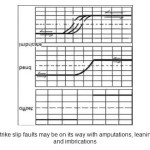 |
Figure 2: Strike slip faults may be on its way with amputations, leaning, diffusion and imbrications Click here to View figure |
Khunik Fault
Khunik fault is the major faults in the region with a length about 6 km along the N150 / 73NE and Rake scratches slip dextral strike-slip mechanism 24NW has a drift component. Along the fault zone it to be an imbricate zone with compression component (Figure 3).
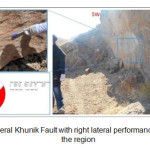 |
Figure 3: right lateral Khunik Fault with right lateral performance parallel duplex of the region Click here to View figure |
Fault 1
This fault has N175 / 70NE and the Rake 29NW and fault mechanism is dextral strike-slip with thrust component.
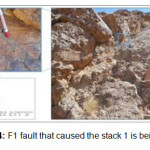 |
Figure 4: F1 fault that caused the stack 1 is being driven Click here to View figure |
Fault 2
This fault has N110 / 63NE and the Rake 30SE and fault mechanism is sinistral strike-slip with a thrust component (Figure 5).
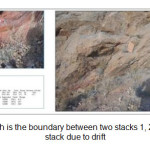 |
Figure 5: F2 which is the boundary between two stacks 1, 2 and 2 to 1 on the stack due to drift Click here to View figure |
Fault 3
This fault has the N100 / 79SW and the Rake 19E and mechanism is dextral strike-slip (Figure 6).
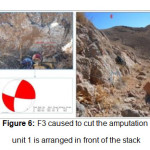 |
Figure 6: F3 caused to cut the amputation unit 1 is arranged in front of the stack Click here to View figure |
Fault 4
This fault has N128 / 55SW and the Rake 27NW, and mechanism is a sinisterly strike-slip with a thrust component (Figure 7).
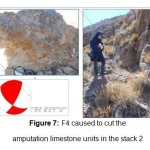 |
Figure 7: F4 caused to cut the amputation limestone units in the stack 2 Click here to View figure |
Fault 5
This fault has N205 / 60NW and the Rake 8 NE and mechanism is a sinisterly strike-slip (Figure 8).
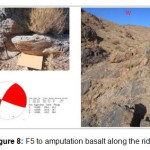 |
Figure 8: F5 to amputation basalt along the ridges Click here to View figure |
Determine the Maximum axis of Stress by the Joints and Faults
Since the study area is abundant systematic joints the best and most appropriate factor to determine the maximum tension joints are removed. The works of any scratches slip joints in areas that have been observed. Harvested joints are indicated lower Cretaceous orbitolina limestone .Images of Systematic joint according to measurements and put on in Fault kin software, the maximum tension in the region, was N115 (Figure 10).
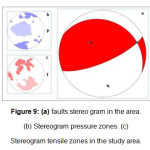 |
Figure 9: (a) faults stereo gram in the area. (b) Stereogram pressure zones. (c) Stereogram tensile zones in the study area. Click here to View figure |
Duplex Structural Analysis by Using Empirical Modeling
For modeling Duplexes and were used sand box testing. In this experiment, three different colors of chalk 2 cm thickness and viscosity of the same, a constant ramp fixed edge of device is used. Enter a force parallel to the layering and layering by lever control agents studied structures during test. The experiment was performed in 4 phase's .Displacement and shortening rate was calculated at each stage. Scale of the experiment is 1: 2500 (ei:1cm in model is equal to 25 meters on the earth).Phases of testing in order to include the first phase of a force parallel to the layering of alternating layers of plaster in three colors and with equal viscosities by a lever inserted. The initial length was 63 cm layer of the stress caused by the first stage thickening occurs at the moving border of the device. At this stage, deformation is the only type of displacement. In the latter stages the first thrust Emerged and percentage of shortening is12.7 percent. With continuing tension in the third stage, and growth of thrusts and continue of placement, moving layer occurs in the moving edge of the device during this phase, the growth of thrusts, is visible. The emergence of the duplex was observed in the rate of shortening at this point, is 18.2 percent and 17.19 cm. In the fourth phase of shortening occurs when the duplex increases are similar in appearance and geometric duplex area. The rate of shortening is equivalent to 27.3percent, which is equivalent to 17.19 cm. in this phase duplex has created with a little angle of 30 to 40 degrees. And the bottom of the heap on top of the lower layer on the bottom of the hanging wall of the stack grows. Fault created in this step is toward the moving edge of the device. The length of the duplex of area is 632 meters after the shortening according to the laboratory model reach to 445 meters the rate of shortening is 187 meters, equivalent to 29.5% (Figure 10). Accordingly, it can be said to begin shortening, gradually formed drift pages. These pages are initially gentle slope and the shortening rate greater, greater the slope. Also faults near the moving border have higher slope. Due to the motion of the ridges, a thrust was created on the back of the device and then forming a stack of two or in continuing of motion of more new thrusts and ridge formed behind them (Figure 11). Based on this model are Imbricate duplex is formed (McClay, 1992) (Figure 12).
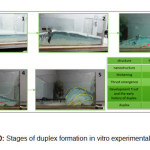 |
Figure 10: Stages of duplex formation in vitro experimental tectonics Click here to View figure |
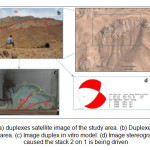 |
Figure 11: (a) duplexes satellite image of the study area. (b) Duplexes field image of Khunik area. (c) Image duplex in vitro model. (d) Image stereograms F2 that caused the stack 2 on 1 is being driven Click here to View figure |
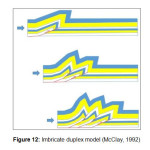 |
Figure 12: Imbricate duplex model (McClay, 1992) Click here to View figure |
Conclusion
Analysis of structural elements in the region represents a movement pattern of a compression system with sinisterly shear. Therefore, the construction of the analysis in this area in east west sinisterly displacement pressure system is consistent. The maximum tension structures corresponded with the N115. Based on experimental modeling, younger thrusts were formed on older thrusts and the steep ridges on the front side (the fixed margin), which is more consistent with field observations. Rate shortening is 27.3% which is equivalent to 178 meters. Due to the fact the shift southeast to the northwest is the youngest of the duplex. Duplex formation of the regional model to follow imbricate duplex model which describes the structural complexity.
Acknowledgement
We thank the members of the Department of Geology, University of Birjand, especially Dr.Ebrahim Gholami, Dr.Seyed Morteza Mousavi and Mr. Saeed Khosravi who helped us in the preparation of this article.
References
- Aghanabati, SA. (2004), "Geological Survey of Iran," Ministry of Industries and mines Geological survey of Iran.
- Bagheri, Manijhe- Qureshi, Manuchehr- Mehdizadeh, Simin. (2006). "Structural analysis of strike-slip duplex Chachm (f) East of Firouzkouh area," Scientific Quarterly journal Geosciences, Vol. 15, 60 number60
- Cunningham and Mann, 2007. Tectonics of strike-slip restraining and releasing bends. Geological society, London, 1, 12-290.
- Dwight c. Bradley and Lauren M. Bradley, 1994. Geometry of an outcrop-scale duplex in Devonian flysch, Maine. U-S. Geological survey, Branch of Alaskan Geology
- Abadi haseli, Farid-Pourkermani, M-Haji Ali Begay, Hussein. (2012). "Structural analysis of compressional duplex compression-slide Morrow (North West of Tabriz)," Scientific Quarterly journal Geosciences, Vol. 7, 25 number
- Woodcock and Mike Fischer, 1985.Strike-slip duplexes. Department of Earth Sciences of Cambridge, Dewing Street Cambridge CB23EQ, U.K.
- R. McClay, Thrust Tectonics, 1992, university
- .Department of Geology Royal Holloway and Bedford New College University of London.
- Richard walker and James Jackson, 2004. Active tectonics and late Cenozoic strain distribution in central and eastern Iran.
- Rashidi, Ahmad -Khatib, Mohammed Mehdi-Heyhat, Mahmud reza- Mousavi, Seyed Morteza. (2008). "Duplex formation mechanism of kamarhaji the mountains in the northwest Birjand," Journal of the Geological Survey of Iran, Vol. 6, No. 22.
- Ghasemi, M. r. (2008). "The geological foundation of the building," Institute of Earth Sciences, Geological the country.






